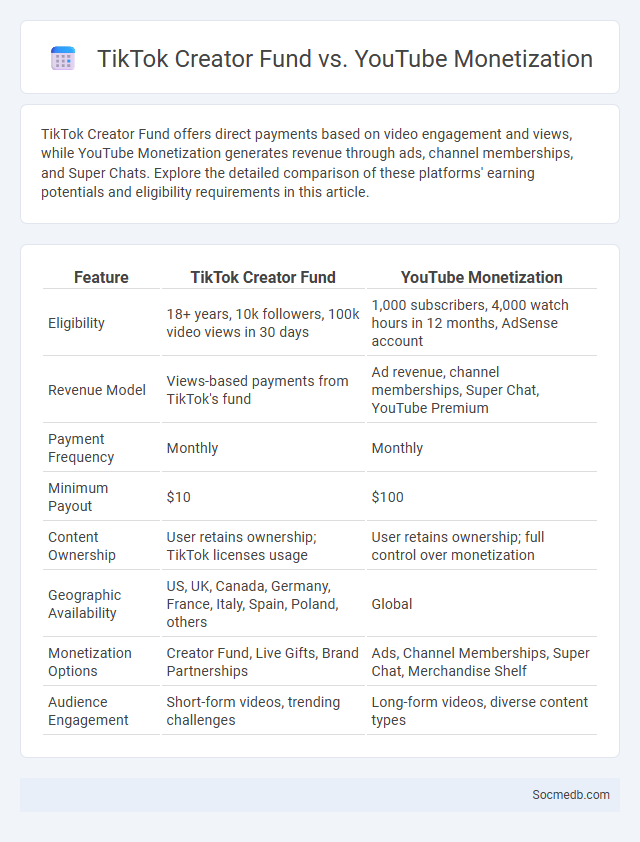
Photo illustration: TikTok Creator Fund vs YouTube Monetization
TikTok Creator Fund offers direct payments based on video engagement and views, while YouTube Monetization generates revenue through ads, channel memberships, and Super Chats. Explore the detailed comparison of these platforms' earning potentials and eligibility requirements in this article.
Table of Comparison
| Feature | TikTok Creator Fund | YouTube Monetization |
|---|---|---|
| Eligibility | 18+ years, 10k followers, 100k video views in 30 days | 1,000 subscribers, 4,000 watch hours in 12 months, AdSense account |
| Revenue Model | Views-based payments from TikTok's fund | Ad revenue, channel memberships, Super Chat, YouTube Premium |
| Payment Frequency | Monthly | Monthly |
| Minimum Payout | $10 | $100 |
| Content Ownership | User retains ownership; TikTok licenses usage | User retains ownership; full control over monetization |
| Geographic Availability | US, UK, Canada, Germany, France, Italy, Spain, Poland, others | Global |
| Monetization Options | Creator Fund, Live Gifts, Brand Partnerships | Ads, Channel Memberships, Super Chat, Merchandise Shelf |
| Audience Engagement | Short-form videos, trending challenges | Long-form videos, diverse content types |
Introduction: Comparing TikTok Creator Fund, YouTube Monetization, and Creator Funds
TikTok Creator Fund, YouTube Monetization, and other creator funds offer diverse revenue opportunities for content creators, each with unique eligibility criteria and payout structures. The TikTok Creator Fund rewards engagement and video views, primarily targeting short-form content creators, while YouTube Monetization combines ad revenue, channel memberships, and Super Chat features for long-form videos. Understanding the distinct algorithms and audience interaction metrics within these platforms facilitates optimizing income streams for digital content creators.
Eligibility Requirements for Each Platform
Each social media platform enforces specific eligibility requirements to ensure user safety and compliance with legal standards. You must typically meet age restrictions, such as being at least 13 years old on Facebook and Instagram, while platforms like TikTok require users to be 13 or older with parental consent if under 18. Verification processes may vary, demanding valid identification or business credentials for features like Facebook Pages or Twitter verification badges.
Revenue Generation Models Explained
Social media platforms generate revenue primarily through advertising by targeting specific user demographics with personalized ads that maximize engagement and conversion rates. Subscription models, such as premium memberships or exclusive content access, provide consistent income by offering enhanced user experiences. You can also explore affiliate marketing and in-app purchases as alternative revenue generation strategies to diversify and increase profitability.
Payment Structures and Payout Methods
Social media platforms use diverse payment structures such as affiliate commissions, ad revenue shares, and sponsored content fees to monetize user engagement. Payout methods commonly include direct bank transfers, PayPal, and digital wallets to ensure timely and secure earnings distribution. You should choose platforms that offer transparent payment terms and multiple payout options to maximize your revenue potential.
Audience Reach and Platform Demographics
Maximizing your social media audience reach requires understanding platform demographics such as age, location, and interests to tailor content effectively. Platforms like Facebook attract a broad age range with a strong presence of users aged 25-54, while Instagram and TikTok dominate younger audiences under 35, providing opportunities for visual and video-driven engagement. Leveraging data on user behavior and preferences enables you to optimize campaign targeting, ensuring your message resonates with the right segments for increased engagement and conversion rates.
Content Types and Algorithm Preferences
Social media platforms prioritize diverse content types such as videos, images, stories, and live streams to maximize user engagement and time spent on the app. Algorithms favor content with high interaction rates, including likes, comments, shares, and watch time, signaling relevance and quality to tailor user feeds effectively. Leveraging trending formats like short-form videos and interactive polls can significantly boost visibility within platform-specific algorithmic preferences.
Pros and Cons of TikTok Creator Fund
The TikTok Creator Fund offers content creators financial incentives based on video performance, encouraging creativity and consistent uploads. However, payment rates can be unpredictable and often lower compared to other monetization platforms, leading to dissatisfaction among creators. Concerns about algorithm transparency and the pressure to produce viral content may affect long-term creator motivation and content quality.
Strengths and Weaknesses of YouTube Monetization
YouTube monetization offers creators the strength of diverse revenue streams, including ad revenue, channel memberships, and Super Chat, enabling substantial income potential and audience engagement. However, weaknesses include stringent eligibility requirements, fluctuating ad rates, and reliance on algorithm changes that can unpredictably impact earnings. Content creators face challenges with demonetization policies and copyright claims that often limit monetization opportunities despite high-quality content.
Creator Fund Alternatives Across Platforms
Creators seeking alternatives to popular social media Creator Funds can explore monetization options such as TikTok's Creator Marketplace, Instagram's Brand Collabs Manager, and YouTube's Partner Program providing ad revenue sharing and Super Chat features. Platforms like Twitch offer subscription-based income and Bits donations, while Patreon allows direct fan support through tiered memberships, enhancing creator earnings beyond traditional creator funds. These diverse monetization tools empower content creators to diversify revenue streams and build sustainable digital careers.
Which Platform Offers the Best Value for Creators?
TikTok offers the best value for creators due to its algorithm-driven content discovery, enabling rapid audience growth and higher engagement rates compared to platforms like Instagram and YouTube. Instagram remains strong for creators focusing on visual storytelling and brand collaborations, with features such as Reels and Shopping enhancing monetization opportunities. YouTube excels in long-form content monetization through ad revenue and memberships, making it ideal for creators seeking sustainable income streams.
 socmedb.com
socmedb.com